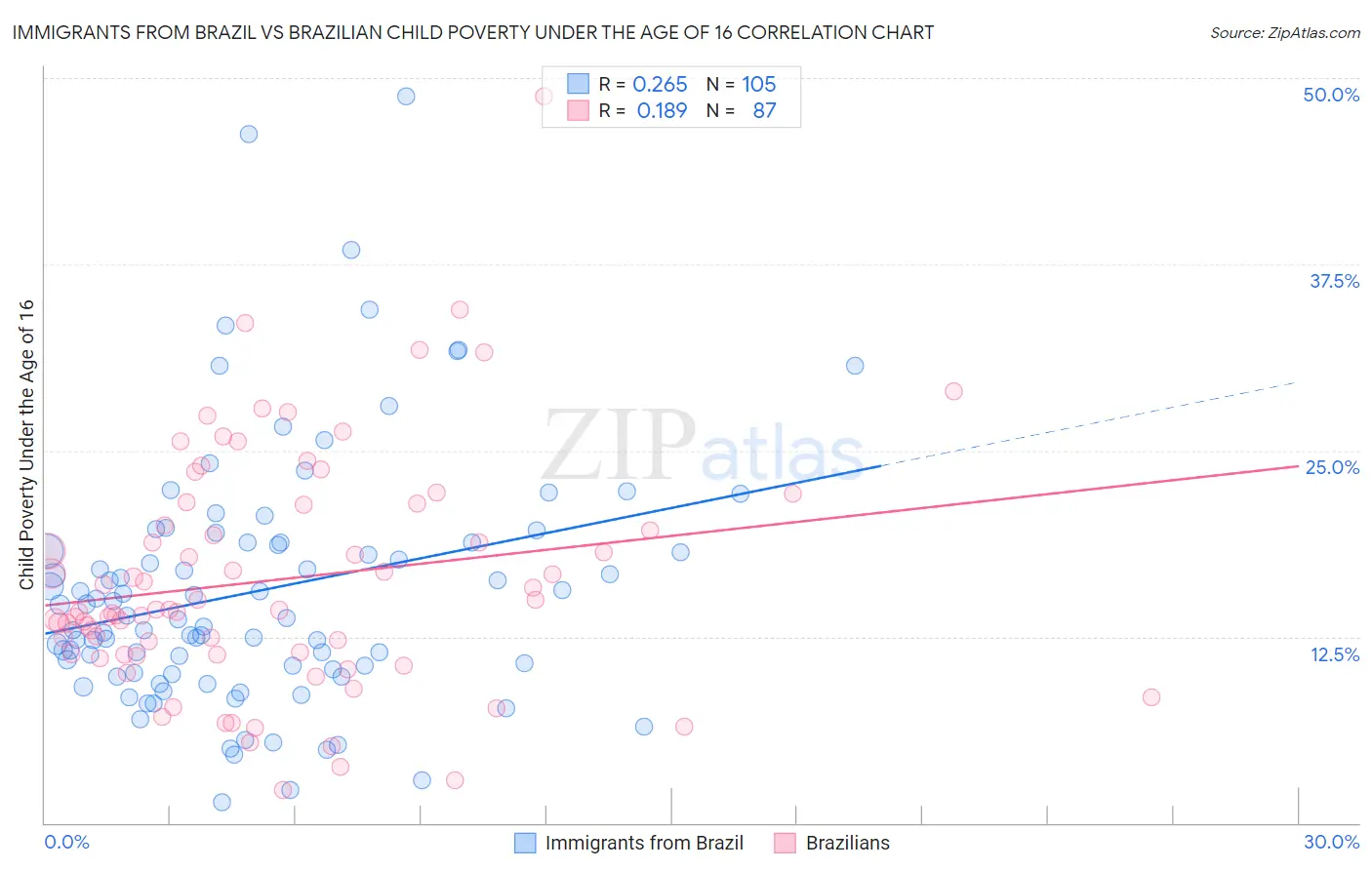Immigrants from Brazil vs Brazilian Child Poverty Under the Age of 16
COMPARE
Immigrants from Brazil
Brazilian
Child Poverty Under the Age of 16
Child Poverty Under the Age of 16 Comparison
Immigrants from Brazil
Brazilians
15.1%
CHILD POVERTY UNDER THE AGE OF 16
91.1/ 100
METRIC RATING
123rd/ 347
METRIC RANK
15.4%
CHILD POVERTY UNDER THE AGE OF 16
82.8/ 100
METRIC RATING
142nd/ 347
METRIC RANK
Immigrants from Brazil vs Brazilian Child Poverty Under the Age of 16 Correlation Chart
The statistical analysis conducted on geographies consisting of 340,154,943 people shows a weak positive correlation between the proportion of Immigrants from Brazil and poverty level among children under the age of 16 in the United States with a correlation coefficient (R) of 0.265 and weighted average of 15.1%. Similarly, the statistical analysis conducted on geographies consisting of 321,388,637 people shows a poor positive correlation between the proportion of Brazilians and poverty level among children under the age of 16 in the United States with a correlation coefficient (R) of 0.189 and weighted average of 15.4%, a difference of 2.4%.

Child Poverty Under the Age of 16 Correlation Summary
| Measurement | Immigrants from Brazil | Brazilian |
| Minimum | 1.4% | 2.2% |
| Maximum | 48.8% | 48.8% |
| Range | 47.4% | 46.6% |
| Mean | 15.6% | 16.3% |
| Median | 13.7% | 14.3% |
| Interquartile 25% (IQ1) | 10.2% | 11.3% |
| Interquartile 75% (IQ3) | 18.8% | 21.3% |
| Interquartile Range (IQR) | 8.6% | 10.0% |
| Standard Deviation (Sample) | 8.5% | 8.0% |
| Standard Deviation (Population) | 8.5% | 8.0% |
Demographics Similar to Immigrants from Brazil and Brazilians by Child Poverty Under the Age of 16
In terms of child poverty under the age of 16, the demographic groups most similar to Immigrants from Brazil are Czechoslovakian (15.1%, a difference of 0.0%), Palestinian (15.1%, a difference of 0.040%), Portuguese (15.1%, a difference of 0.19%), Pakistani (15.0%, a difference of 0.24%), and Immigrants from Western Europe (15.1%, a difference of 0.28%). Similarly, the demographic groups most similar to Brazilians are Slavic (15.4%, a difference of 0.34%), New Zealander (15.3%, a difference of 1.0%), Immigrants from Vietnam (15.3%, a difference of 1.1%), Welsh (15.3%, a difference of 1.1%), and Peruvian (15.3%, a difference of 1.1%).
| Demographics | Rating | Rank | Child Poverty Under the Age of 16 |
| Pakistanis | 91.7 /100 | #122 | Exceptional 15.0% |
| Immigrants | Brazil | 91.1 /100 | #123 | Exceptional 15.1% |
| Czechoslovakians | 91.0 /100 | #124 | Exceptional 15.1% |
| Palestinians | 90.9 /100 | #125 | Exceptional 15.1% |
| Portuguese | 90.6 /100 | #126 | Exceptional 15.1% |
| Immigrants | Western Europe | 90.3 /100 | #127 | Exceptional 15.1% |
| Immigrants | Kazakhstan | 90.2 /100 | #128 | Exceptional 15.1% |
| Immigrants | Southern Europe | 89.7 /100 | #129 | Excellent 15.1% |
| Mongolians | 89.5 /100 | #130 | Excellent 15.2% |
| Armenians | 89.4 /100 | #131 | Excellent 15.2% |
| Canadians | 89.1 /100 | #132 | Excellent 15.2% |
| Immigrants | South Eastern Asia | 89.0 /100 | #133 | Excellent 15.2% |
| Native Hawaiians | 88.7 /100 | #134 | Excellent 15.2% |
| Albanians | 88.6 /100 | #135 | Excellent 15.2% |
| Immigrants | Spain | 87.3 /100 | #136 | Excellent 15.3% |
| Peruvians | 87.2 /100 | #137 | Excellent 15.3% |
| Welsh | 87.2 /100 | #138 | Excellent 15.3% |
| Immigrants | Vietnam | 87.1 /100 | #139 | Excellent 15.3% |
| New Zealanders | 86.9 /100 | #140 | Excellent 15.3% |
| Slavs | 84.2 /100 | #141 | Excellent 15.4% |
| Brazilians | 82.8 /100 | #142 | Excellent 15.4% |